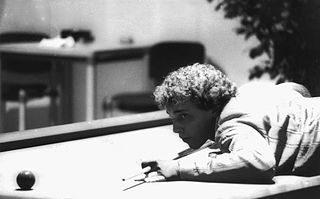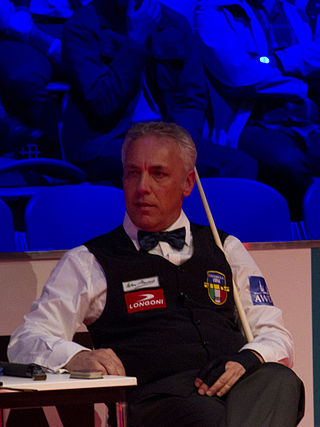
Carom billiards, also called French billiards and sometimes carambole billiards, is the overarching title of a family of cue sports generally played on cloth-covered, pocketless billiard tables. In its simplest form, the object of the game is to score points or "counts" by caroming one's own cue ball off both the opponent's cue ball and the object ball on a single shot. The invention as well as the exact date of origin of carom billiards is somewhat obscure but is thought to be traceable to 18th-century France.

Raymond Ceulemans is a Belgian billiards player who won 21 UMB three-cushion World Championship titles, more than any other player. Along with 48 European titles and 61 national titles. His nickname is "Mr 100". He was inducted into the Billiard Congress of America's Hall of Fame in 2001, one of the first non-Americans to receive the honour.

Semih Saygıner, nicknamed Mr. Magic or The Turkish Prince, is a Turkish world champion professional carom billiards player specialized in three-cushion event.

Dingeman Jacobus Johannes "Dick" Jaspers is a Dutch professional carom billiards player who specializes in the three-cushion event.

One-cushion billiards is a carom billiards discipline generally played on a cloth-covered, 10-by-5-foot, pocketless billiard table with two cue balls and a third red-colored ball. In a one-cushion shot, the cue ball caroms off both object balls with at least one rail being struck before the hit on the second object ball. The object of the game is to score up to an agreed upon number of cushion caroms, with one point being awarded for each successfully made. If no object ball is contacted, one point is deducted. If there is ambiguity as to whether the second ball was contacted, it is resolved against the shooter. It is governed by the Union Mondiale de Billard, the world governing body of carom billiards.

Five-pin billiards or simply five-pins or 5-pins, is today usually a carom billiards form of cue sport, though sometimes still played on a pocket table. In addition to the customary three balls of most carom games, it makes use of a set of five upright pins (skittles) arranged in a "+" pattern at the center of the table. The game is popular especially in Italy and Argentina, but also in some other parts of Latin America and Europe, with international, televised professional tournaments. It is sometimes referred to as Italian five-pins or Italian billiards, or as simply italiana. A variant of the game, goriziana or nine-pins, adds additional skittles to the formation. A related pocket game, with larger pins, is played in Scandinavia and is referred to in English as Danish pin billiards, with a Swedish variant that has some rules more similar to the Italian game.

The World Union of Billards is the world governing body for carom (carambole) billiard games.

Torbjörn Blomdahl is a Swedish professional carom billiards player from Helsingborg, Sweden who plays for FC Porto. He is a seven time World Champion in three-cushion billiards, having won the titles in 1987, 1988, 1991, 1992, 1997, 2015 and in 2019.

Marco Zanetti is an Italian professional three-cushion billiards player and a two-time world champion from Bolzano, Italy.

Daniel Sánchez Gálvez is a Spanish professional carom billiards player who plays for FC Porto a club he has represented for the last 21 years.

The Verhoeven Open is a three-cushion billiards tournament held in Flushing, Queens in the US state of New York. The event is sanctioned by the Union Mondiale de Billard and the United States Billiard Association. The event was known as Sang Lee International Open between 2005 and 2008.
The CEB European Three-cushion Championship is three-cushion billiards tournament organized by the Confédération Européenne de Billard. Held since 1932, it is one of longest-running tournaments in the sport. The 2007 event offered a total purse of €18,500 (US$26,134) with €4,000 ($5,651) for the winner.

Eddy Merckx is a Belgian professional three-cushion billiards player.

Masako Katsura, nicknamed "Katsy" and sometimes called the "First Lady of Billiards", was a Japanese carom billiards player who was most active in the 1950s. She was the first woman to compete and place among the best in the male-dominated world of professional billiards. First learning the game from her brother-in-law and then under the tutelage of Japanese champion Kinrey Matsuyama, Katsura became Japan's only female professional player. In competition in Japan, she took second place in the country's national three-cushion billiards championship three times. In exhibition she was noted for running 10,000 points at the game of straight rail.

Eddy Leppens is a Belgian professional three cushion billiards player.
The Crystal Kelly Cup or Crystal Kelly Tournament was a prestigious, generously funded carom billiards invitational tournament in the discipline of three-cushion, which has been held at different venues from 1994 to 2011, a total of 18 times, mostly in Monte Carlo and Nice.

The Three-Cushion World Cup is an international tournament series in three-cushion billiards, which is held every year since 1986 between three and ten times a year.

Choi Sung-won is a South Korean professional billiards player.

Pedro Leopoldo Carrera was an Argentine carom billiards player and the first player to set a general average of 1,000 or more. Carrera was a five time carom billiards world champion. He won the straight rail world championship in 1950 and 1953, the 47.2 balkline world championship in 1951, and the Union Internationale des Fédérations des Amateurs de Billard (UIFAB) World Three-cushion Championship in 1952 and UIFAB pentathlon world cup in 1954. In 1980, more than 17 years after his death, Carrera was awarded the Premios Konex in platinum posthumously as the best billiard player in Argentine history and also with the "Diploma al Mérito".

Avelino Rico is a Spanish carom billiards player. He won at the UMB World Three-cushion Championship in 1986, having a match against Torbjörn Blomdahl and Raymond Ceulemans. Rico also placed second at the CEB European Three-cushion Championship in 1986. He participated at the Spanish Championships, receiving ten wins.




















